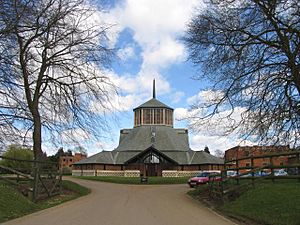Douai Abbey facts for kids
Quick facts for kids Douai Abbey |
|
|---|---|
 |
|
| Lua error in Module:Location_map at line 420: attempt to index field 'wikibase' (a nil value). | |
| OS grid reference | SU5770468214 |
| Location | Woolhampton, Berkshire |
| Country | United Kingdom |
| Denomination | Roman Catholic |
| Website | www.douaiabbey.org.uk |
| History | |
| Status | Monastery |
| Founded | 1615 |
| Founder(s) | Dom Gabriel Gifford |
| Dedication | St Edmund the Martyr |
| Dedicated | 1933 |
| Events | 1615 Founded in Paris 1818 Moved to Douai |
| Architecture | |
| Functional status | Active |
| Heritage designation | Grade II* |
| Designated | 10 November 1980 |
| Architect(s) | J Arnold Crush |
| Style | Gothic Revival |
| Groundbreaking | 1903 |
| Completed | 1993 |
| Administration | |
| Deanery | West Berkshire |
| Diocese | Portsmouth |
| Province | Southwark |
Douai Abbey is a special place where Benedictine monks live and pray. It's located in Upper Woolhampton, a village in Berkshire, England. This abbey is part of the Roman Catholic Diocese of Portsmouth.
The monks who live here came from a monastery called St. Edmund's in Douai, France. They moved to Woolhampton in 1903. This happened because of new laws in France that made it difficult for religious groups to stay. The main church at Douai Abbey is a very important building. It is listed as Grade II* on the National Heritage List for England.
Contents
History of Douai Abbey
The community of monks at Douai Abbey started a long time ago. It was formed in Paris, France, in 1615. A person named Dom Gabriel Gifford helped to create this community. He later became an important leader in the church, the Archbishop of Rheims. With his support, the community grew and became strong.
Moving to England
During the French Revolution, the monks had to leave Paris. In 1818, they moved to empty buildings in Douai, another city in France. Around the early 1900s, there were political changes in France. The French prime minister introduced a law in 1901. This law made it harder for religious groups to operate freely.
Because of these new laws, the monks had to leave France again. In 1903, Bishop Cahill of Portsmouth offered them a place in Woolhampton, England. This place was a small school called St Mary's. The abbey church in Woolhampton was opened in 1933. However, it took a long time to finish building it, finally completed in 1993, because of money problems.
In the 1960s, the monastery was made much bigger. Sir Frederick Gibberd designed the new buildings. The abbey also used to run a school called Douai School. This school closed in 1999. In 2005, some monks went back to Douai, France. They started a new community there to remember their old connections.
Douai Abbey and Royal History
Douai Abbey and its monks have a special connection to the Stuart dynasty. This was a royal family that once ruled England, Scotland, and Ireland. They also supported the Jacobite cause. This cause was about bringing the Stuart family back to the throne.
King James II of England was buried near Paris. This was where the monks lived before they moved to Douai. Some members of the House of Wittelsbach also studied at the abbey's old school. This family is considered by some to be the current heirs to the Jacobite claim. The abbot who led the abbey until recently, Geoffrey Scott OSB, is also a member of the Jacobite Society.
Douai Abbey Today
Douai Abbey is still an active monastery. In July 2014, a monk became a priest there. This was the first time a priest had been ordained at the abbey since 2007. The community currently has 23 monks. These monks serve in churches across five different areas. The monastery's special saint is St Edmund King and Martyr. His feast day is celebrated on November 20.
Music at the Abbey
The Abbey Church is a great place for music. It has two large pipe organs. One is a smaller organ from 1978, made in an Italian style by Tamburini. The other is a bigger organ from 1994. It was made by Kenneth Tickell in a modern English style.
Special Acoustics
The Abbey Church is known for its unique sound. It has a special echo that makes music sound amazing. Because of this, many musicians use the Abbey Church to record their albums.
Famous Recordings
Some of the famous albums recorded at Douai Abbey include:
- Carlo Gesualdo - Tenebrae by The Hilliard Ensemble (March 1990).
- Pierre de la Rue - Missa Cum Iocunditate, Motets by The Hilliard Ensemble (1997).
- The Old Hall Manuscript by The Hilliard Ensemble (1990).
- Cristobal de Morales - Mass For The Feast Of St. Isidore Of Seville by the Gabrieli Consort & Players, directed by Paul McCreesh (2003).
- A New Venetian Coronation 1595 by the Gabrieli Consort & Players, directed by Paul McCreesh (2012).
- Handel Organ Concertos by Baroque Belles and David Willcocks (1999).
- MacMillan And His British Contemporaries by the choir of New College, Oxford (2006).
- Rutter: Requiem by the choir of Clare College, Cambridge (2003).
Leaders of Douai Abbey
Here is a list of the Abbots who have led Douai Abbey:
- 1900–1904: Lawrence Larkin
- 1904–1905: Ambrose Bamford
- 1905–1913: Stanislaus Taylor
- 1913–1921: David Hurley
- 1921–1929: Edmund Kelly
- 1929–1969: Sylvester Mooney
- 1969–1989: Gregory Freeman
- 1989–1990: Leonard Vickers
- 1990–1998: Finbar Kealy
- 1998–2022: Geoffrey Scott
- 2022-present: Paul Gunter
Images for kids
More to Explore
- Douai, France
- Douai School
- English College, Douai
- English Benedictine Congregation




